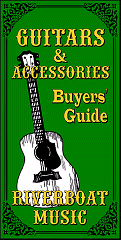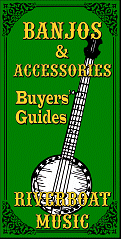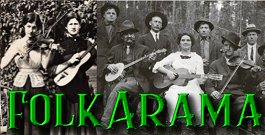
A Favorite of Many Blues Players - and Some Folk Singers
| Please Read: How to Help Our Site at No Cost to You - Some of our articles contain recommendations for products we like and vendors we personally trust. Some of those vendors may pay us a very small commission if you click on a link and buy their products. This costs you nothing at all and helps offset the costs of what we do. So if we point you to something you decide to buy later, please make certain you come back through our site and click on the link directly. Thanks. |
| This Site is a Cookie-Free Zone - Except for discussion forums that you have to expressly register for, none of our pages use cookies of any kind. Some of the vendors we link to do, but that won't affect you unless you click on a link to their pages. Your continued use of this page indicates that you agree to our policy. For details, click here. |



|


E Major, a Cornerstone of Blues and Folk
This is part of the "VERY Basic Guitar subset of our "How To Folk" articles. In an effort to "jump start" your enjoyment of Folk music and your ability to join in, no matter what instrument you play, we are providing some very basic notes about guitar chords.

 Note: - This part of the Folkarama page, which is dedicated to helping beginners "get into" Folk music and join Folk communities as easily as possible, with simple articles and links to resources that provide hands-on instruction in traditional acoustic instruments.
Note: - This part of the Folkarama page, which is dedicated to helping beginners "get into" Folk music and join Folk communities as easily as possible, with simple articles and links to resources that provide hands-on instruction in traditional acoustic instruments.
Folkarama, in turn, contains many references to more extensive articles and resources in Paul Race's CreekDontRise.com site, as well as other related pages.
Previously on "Basic Guitar"
Hopefully, you have already worked your way through these materials:- Meet Your Guitar - a very basic intro to holding, tuning, and picking the guitar.
- Three Magic Chords - a three-part series to introduce enough easy guitar chords to get you started on learning scores of 2-chord songs.
And you may or may not have worked through these:
- C and C9 Chords - Once you've learned the "Three Magic Chords," the C chord will help you play thousands of 3-chord songs in G, but some folks find it cumbersome at first, so we've given you a "workaround" to use while you're getting used to it.
- It's All Relative - Am and Em - The fingerings and most common uses of guitar's easiest minor chords, Am and Em. We also sneak in Am7, Em7, and Bm7 to expand your chord vocabulary.
- A Major - the Fiddler's Friend - a popular Folk, Pop, and Fiddler key.

E Major and its Friends
By now, you should be pretty familiar with E7, the A chord's most valuable sidekick. To make an E major chord, you have to add an extra finger to the chord.E Major is the last "open chord" we'll be presenting in this series. "Open" means that there are two or more unfretted strings that you can allow to sustain while you're changing to the next chord for a smoother sound. They are a mainstay of Folk guitar and popular in every style that uses acoustic instruments.
The key of E major is very popular among Blues guitarists, and it has been used to great purpose by folks like James Taylor and John Denver. If a "three-chorder" you would ordinarily sing in D (using D, G, and A7) is a little low for your voice, you'll do better in E, using E, A, and B7.
You should have learned A by now if you were doing our lessons in sequence. But B7 is its own animal, so to speak. 
Many people play B7 using "barre" chords, which we'll get to later. But there is a root position B7 you can use if you're not up to barre chords yet.
Depending on your vocal range, nearly any "three-chorder" you can play in D can be played in E.
For practice, you can go to the Three-Chord Songs in D page Then, instead of using D, B7, and G, you use E, B7, and A.
I'm also told that the following songs work very well in E and may originally have been played in those keys.
- Fleetwood Mac's "Don't Stop Thinking About Tomorrow"
- Dire Straits' "Walk of Life"
I noticed several others that you would probably know, but they used chords we haven't introduced yet, including C# minor, the relative minor of E.

At the right is a "cheater" version of C# minor, shown as C#m in chord charts. You can use this to substitute for C#m7 as well. Most experienced guitar players would use a different, better version than this, but it might help you get through a song you really, really want to learn or were drafted into playing at the last minute.
E Major and the Blues - Most muggles think that "the Blues" is just a sort of sad song, maybe with some "bluesy-sounding" chords. But "The Blues" uses a specific sort of chord progression that works especially well in the keys of E and G (which you should already know).
The most common progression is called a "12-bar blues." If you're playing it in E, that would involve four measures of E, two measures of A, two measures of E, one measure of B7, one measure of A, and two measures of E.
If you know "Give Me One Reason to Stay Here," try the following:
- Play E and sing "Give me one reason to stay here, and I'll turn right back around.
- Play A and sing "Give me one reason to stay here, and I'll turn right back a-"
- Play E and sing "-round. Because I"
- Play B7 and sing "don't want to leave you lonely, but"
- Play A and sing "you got to make me change my "
- Play E and sing "mind."
On many 12-bar blues in E, including this one, there are a couple other chord changes, but this gives you the general idea. The most common variation would be to sing the first line like this:
- Play E and sing "Give me one reason to stay here,"
- Play A and sing "I'll turn right back a-"
- Play E and sing "-round."
The rest of the song would go about the same.
"Blue Notes" and E7 - One other characteristic of "The Blues" is notes that may be played a half-step lower than they "should be" for the key of the song. These are called "Blue Notes." (Once you know what they are, you'll have no trouble recognizing them in Rock and Jazz, as well as in most Bluegrass banjo solos.)
The most common blue note is what is often called a "flatted seventh," that is a note seven steps higher than the root note of the chord, but which is a whole step from the octave.
If you're playing in the key of E, the seventh note of the scale "should be" D#. In the Blues, it's a D - a half-step lower than it "should be."
For that matter, the seventh note of the A scale "should be" G#. But in the Blues, it's a G more often than not.
So if you want an especially "bluesy" sound in your playing, you can substitute E7 for E major, and A7 for a major.
Go back to "Give Me One Reason," and sing it with E7, B7, and A7 instead of E, B7, and A. You'll see what I mean.
You'll also see why E is one of the most popular keys for the Blues.
The following illustration shows how the chords in a traditional E major Blues would work. Modern Blues players may substitute other chords, but generally the pattern stays the same. (If you can't read the fine print, click on the picture to see a "blowup.")
As you may notice, a traditional Blues has three lines, but the second line is usually a repeat of the first line. The third line is a "payoff" line of sorts. Sometimes it just offers more information, but often it puts the sentiment expressed in the first two lines into some sort of context.
As I mentioned earlier, the other popular key for Blues is G. Simply replace E7, A7, and B7 with G7, C7, and D7. (No, we haven't shown you G7 and C7 yet, but you can find them on most chord charts, and you can use G and C in the meantime.)
Why do you need to know how a 12-bar Blues works? To keep you from getting laughed out of a jam when somebody says, "This is a Blues in G" and you ask "What are the chords?" The correct answer to that question is, "Duh."
It's also worth pointing out that the 12-bar Blues progression was critical to the early development of Rock and Roll, supporting hits like "Johnny B. Goode" and "Blue Suede Shoes." Countless hits then and since have either used the 12-bar format outright or borrowed aspects of it. (Creedence's "Traveling Band," for example.) So if you ever find yourself in a Rock jam, this knowledge will still be useful. Or if you are performing and you wish the crowd was a little more lively.*
Conclusion
If you read our "What is a Three-Chorder?" article, you saw a chart that showed the relationships between the C, G, D, A, and E chords, and how each three-chord cluster could be used in a "three-chorder."At this point, we've shown you all of the "open" major chords on the guitar, each in the position closest to the nut. We have one chord to show you - F - before we move on to "barre" chords, the kind that allow you to play every major, minor, seventh, and minor seventh chord, no matter the key, but a kind that takes another approach.
In the meantime, all Folk, Bluegrass, and Country guitar players know the relationships between these chords by heart, whether they've studied them, or just played them so long they're second nature.

Keep practicing, and don't stop learning. Once again, when you know your own instrument, whatever it is, being able to recognize these chord patterns in a song and recognize the chords other folks are playing on guitar, you should be able to jump in and add something worthwhile without coaching or hints on 90% of the songs out there.
*In 1971, I was playing tenor sax in a cover Rock band and we were short of material. I started playing a boogie-woogie bass line at Rock tempo in a 12-bar blues. The band knew what I was doing and joined in. Not having a particular song in mind, I changed the words to "CC Rider" and sang, "Crazy-Eyed Woman, don't you know what you've done, etc." The crowd loved it. (Think of Marty McFly launching into "Johnny B. Goode" in Back to the Future.)
The thing is, the crowd didn't need to know which song we were playing. They recognized the style - up-tempo old-time Rock and Roll, with a feel similar to "Tutti Frutti," "Johnny B. Goode," "Rock Around the Clock," and a host of others. A night of such songs might turn boring, but to hear one song in a set that used that pattern shook things up, as it were.
It became a permanent part of our set list, and always perked things up. Years later, the leader of that band still likes to remind me of the song I "wrote." I never had the heart to tell him I "borrowed" 98% of it.
Other Resources
Related resources include:- Meet Your Guitar - A brief introduction to the parts of the guitar and how to hold it.
- Three Magic Chords - A series of articles that get you started on basic chords you can use to play thousands of songs. Articles include:
- 3-Chord Songs in D - A list of songs you can easily play in D, using G and A7.
- What is a "Three-Chorder"? - The three-chord pattern that defines countless songs.
- More Useful Chords - "Next steps" to expand your range and enable you to play even more songs, including:
- C and C9 Chords - Once you've learned the "Three Magic Chords," the C chord will help you play thousands of 3-chord songs in G, but some folks find it cumbersome at first, so we've given you a "workaround" to use while you're getting used to it.
- It's All Relative - Am and Em - The fingerings and most common uses of guitar's easiest minor chords, Am and Em. We also sneak in Am7, Em7, and Bm7 to expand your chord vocabulary.
- A Major - the Fiddler's Friend - Expand your chord arsenal with A major and its BFF, E7.
Other resources will be listed as I get to them.
- 3-Chord Songs in G - A list of songs you can easily play in G using G, C9 (or C) and D7.
- The Circle of Fifths - a deeper discussion of the relationships among chords, something that helps musicians quickly learn or follow new songs, or even transpose them to other keys. (This is on our sister site, CreekDontRise.com)
Sister Sites
 Other sites we started to keep this site from getting too big to be useful include:
Other sites we started to keep this site from getting too big to be useful include:
- CreekDontRise.com is a repository of articles about Folk music and the instruments on which it has been traditionally played.
The "Acoustic" page includes a long list of articles including maintenance and playing tips on all sorts of traditional acoustic instruments.
 RiverboatMusic.com is a buyers' guide for acoustic and traditional instrument from a musician's point of view, focusing on the uses, reliability, and practicality of various instruments, and not just the marketing hype about the shape of the fret markers or whatever.
RiverboatMusic.com is a buyers' guide for acoustic and traditional instrument from a musician's point of view, focusing on the uses, reliability, and practicality of various instruments, and not just the marketing hype about the shape of the fret markers or whatever.
For instruments like dulcimers that have mostly small manufacturers or cheap imports, we try to tell you what to look for, irrespective of brand.
 Momma Don't 'Low includes a free e-mail newsletter that discusses all of those topics above and more. We plan to include other features as time permits.
Momma Don't 'Low includes a free e-mail newsletter that discusses all of those topics above and more. We plan to include other features as time permits.
Note - If you wish to sign up for our newsletter and ask a question at the same time, please click on the Momma Don't 'Low newsletter button to learn more and to get a link to our signup form.
 PaulRaceMusic.com is the "landing page" for Paul's own musical endeavors, plus many memoirs and blogs about music and the music business.
PaulRaceMusic.com is the "landing page" for Paul's own musical endeavors, plus many memoirs and blogs about music and the music business.
 ClassicTrainSongs.com describes railroad songs that every train lover should know. Or at least know about.
ClassicTrainSongs.com describes railroad songs that every train lover should know. Or at least know about.
- SchoolOfTheRock.com has articles about Christian music, Christian music careers and performance, Christian living in general, and vintage saxophones, another of Paul's interests. This site has separate newsletters, etc., by the way - there isn't a lot of overlap with the Momma Don't 'Low(tm) newsletters.
For information about other music collections and projects, check the links at the bottom of this page.
 Whatever else you get out of our pages, I hope you come away with some great ideas for "sharing the joy."
Whatever else you get out of our pages, I hope you come away with some great ideas for "sharing the joy."
And please stay in touch!
All material, illustrations, and content of this web site is copyrighted (c) 2001, 2002, 2003, 2004, 2005, 2006,
2007, 2008, 2009, 2010, 2011, 2012, 2013, 2014, 2015, 2016, 2017, 2018, 2019, 2020, 2021, 2022, 2023 by Paul D. Race. All rights reserved.
Creek Dont' RiseTM is a participant in the Amazon Services LLC Associates Program, an affiliate advertising
program designed to provide a means for sites to earn advertising fees by advertising and linking to Amazon.com.
For questions, comments, suggestions, trouble reports, etc. about this page or this site, please contact us.
| Visit related pages and affiliated sites: | |||||
| - Music - | |||||

|
 |
 |

|

|

|

|

|

|

|

|

|

|

|

|

|

|

|
| - Trains and Hobbies - | |||||
 |

|

|  |
 |

|
| - Christmas Memories and Collectibles - | |||||
 |

|
 |

|
 |

|
| - Family Activities and Crafts - | |||||
 |

|

|

|

|

|


